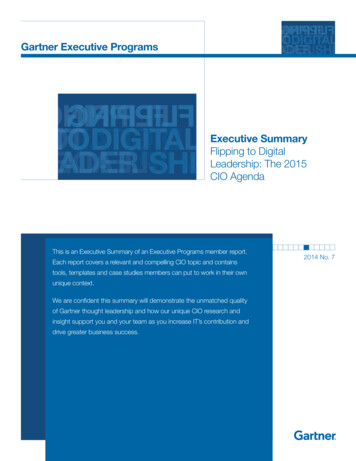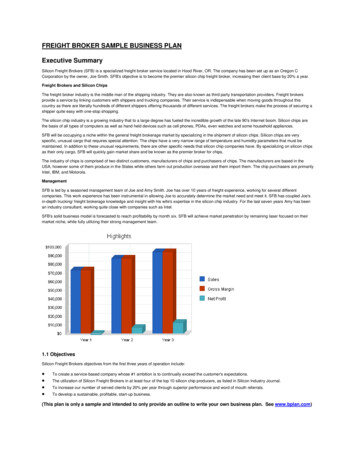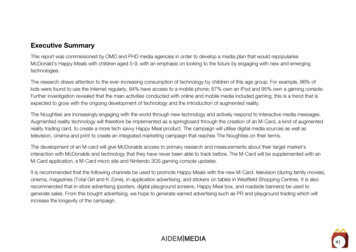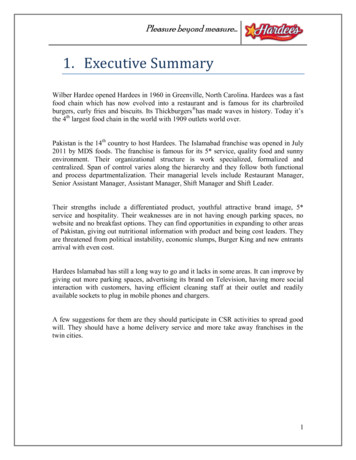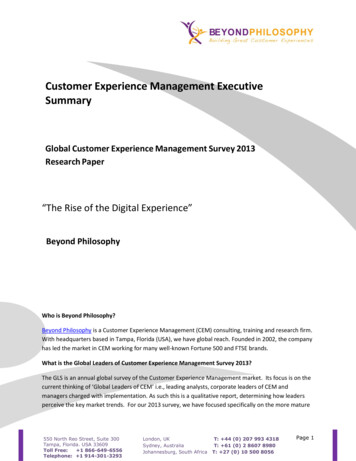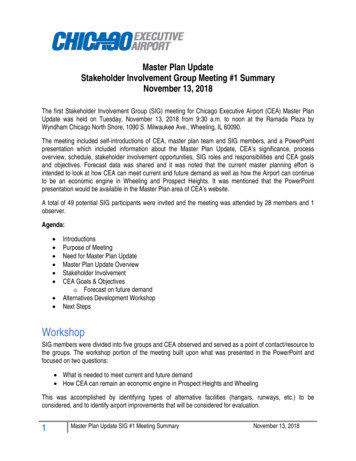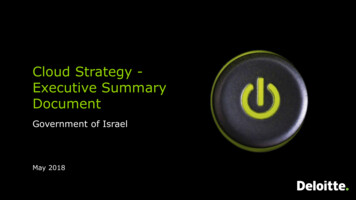
Transcription
Cloud Strategy Executive SummaryDocumentGovernment of IsraelMay 2018 Deloitte LLP and affiliated entities.
The project was delivered over 3 distinct phasesScope Phase 1 – Review, Analyze and Update Existing Policies Phase 2 – Analyze the Current State Phase 3 – Roadmap and PlanMain Objectives Validate and refine the current Cloud policy Create Cloud guidelines Create a Cloud transition roadmap Provide guidelines for the rest of the journey Deloitte LLP and affiliated entities.2
Lets start with a reminder – key characteristics of a government Cloud platformDynamicSelf-ServiceMulti-BusinessOn-Demand Provisioning. Theability to add capability andcapacity as rapidly as businessrequiresCreating environments,enhancing capabilities, addingcapacity with less labor andreduced lead timesCloud computing deliversshared capacity acrossbusiness lines, reducingduplicate environmentsScalableFlexible PricingDigital-Based ArchitectureReact quickly to increasedbusiness demand, acquisitions,or new business modelswithout large CapExexpenditures and increasedlong run-off periodsRecapture capacity and spendfor use in other areas asbusiness demands fluctuatesCloud architectures are basedon virtualized environmentsdefined by their use notby hardware Deloitte LLP and affiliated entities.3
Cloud is consumed in an “as a service” modelSoftware-as-a-ServiceOperating SystemServers, Storage, NetworkFacilities / Monitoring / SupportPublicHybridOff-premisesor externalDEPLOYMENT MODEL Deloitte LLP and affiliated entities.Platform-as-a-ServiceReady-to-use scalable integratedapplication and data hostingInfrastructure-as-a-ServiceHorizontally scalable compute,storage and networking deliveredto an application on-demandPrivateIntegratedOn premisepublic &or internalprivate serviceLess controlMore controlApplication Hosting PlatformSERVICE MODELMiddlewareSoftware that provides a specificbuilt-for-purpose business service tothe clientLess controlServices and ApplicationsMore controlDepending on the service model various layers of complexity are abstracted awayfrom the customer. SaaS model provides the highest level of abstraction and hencethe lowest level of control over the underlying platform and infrastructure.4
Digital government initiatives are key drivers for CloudDigital Government is here, and Cloud computing is the imperative to making a realdifference in citizens lives, while enabling cost effectiveness and IT agility.Governments world-wide are realizing Cloud's potential to drive cost savings, workaround budget reductions, and ultimately deliver more with less. Deloitte LLP and affiliated entities.5
Cloud drives numerous benefits for GovernmentsIncreased Ministry agilityInnovationGain greater flexibility on architecture andsourcing, scale up and down as needed,maximize efficiency, accelerate time to value,reduce time to start up and complete projectsShift focus from asset ownership to services;tap into private sector innovation andencourage an entrepreneurial culture to betterlink to emerging technologiesReduce IT capital spendingReallocation of resourcesUse of “pay-as-you-go” model insteadpurchase / lease and move IT costs fromCAPEX to OPEXAs routine processes are automated throughCloud, resources can be re-positioned tohigher value-add activitiesDevelop the Israeli technology economyDrive job creation in IsraelDevelop the ecosystem of technologyproviders within Israel through firmssupporting the Government Cloud initiativesDrive job creation through leveraging localtechnology companies as part of the solutiondeliveryNumerous governments such as US, UK, Australia, Hong Kong, India, Estonia and others are driving significantbenefits from moving to the Cloud Deloitte LLP and affiliated entities.6
The Government will need to undertake a “journey” in order to be successful in it’sadoption of CloudQuestionHow can leadership respond more quickly to emerging threats,opportunities, and program dynamics with Cloud?QuestionHow do we align relevant stakeholders andbusiness outcomes along a common journey andstrategy?Outcomes Coalesce stakeholders and early adopters Inventory pilots, target outcomes and neededinteractions Identify key decisions and risks, timing andgaps Develop roadmap and identify Cloud enablementpartnersQuestionWhat is C l oud and how can itenable better outcomes for mybusiness?OutcomeUnderstand Cloud's valueproposition for business and ITQuestionHow does Cloud become a core IT service anddeliver business results?Outcomes Accepted and trusted as valid IT service Able to deliver project benefits consistently Integrated into your IT operating model Anticipate needs for full operating capabilityENGAGEQuestionHow can I make Cloud work in my business andorganizational context?Outcomes Understand Cloud models and markets Determine which Cloud capabilities arerelevant to the business Deloitte LLP and affiliated entities.Optimize to key business drivers (cost, responsiveness,accuracy, and competition)INNOVATESCALEQuestionHow can Cloud unlock innovation in theorganization?ADOPTQuestionHow do we address the people, process, and technology implicationsof re-configuring the operating model?INITIATE OPTIMIZEMOBILIZECONVERGEOutcomes Leadership to plan and enhance program objectivesOutcomes Validate operating model framework Clearly defined operational readiness posture and gaps Demonstrate program benefits and secure wider buy-infrom the organization Identify requisite financial, governance, risk andcompliance enhancementsQuestionAre we responding to program demands with therequisite pace, agility, and business focus needed?Outcomes Well refined services catalog Well managed pipeline and SLA fordelivering capabilities deterministically Fully operational capabilities withpredictable IT costs and missioncapabilitiesOutcomes IT effort geared towards drivinginnovation rather than managingoperations Accelerated speed to market anditerative evolution of new ideas7
A series of deliverables were developed during the projectPhase 1 - Review and analyzePhase 2 - Collect data Review and update the current Cloud& security policy Develop a template to be used to gather the requirements Review Cloud infrastructure pros & cons Cloud requirements summary and analysis based on the abovecollected data Risks analysis analysis of the requirements gathered, to develop a draft view ofthe required services and solutions to be delivered by the CloudsolutionPhase 3 - Roadmap and Plan Detailed analysis of 3 precedents Bidders mapping with a reference to potential vendors Future Cloud landscape Recommendations to systems categories that will not migrate tothe Cloud infrastructure High Level cost & sizing estimations High level business case Guidelines to monitor and control mechanisms Cloudinfrastructure Cloud transition roadmap Guidelines for Cloud contracting Identification of activities required by the government agencies toprepare for the Cloud migration Guidelines for RFP creation Service catalog guidelines SLA guidelines8 Deloitte LLP and affiliated entities.8
As the Israeli government starts their migration to Cloud security and privacyprotection continues to remain one of the key risk considerations for government ClouddeploymentsPRIVACY PROTECTIONHow do I deal with regulatoryrequirements regarding privacyprotection of information?DATA MANAGEMENT ®ULATORY COMPLIANCEIs my customer and employeedata safe in Cloud? How do Icontrol where my data goes?CloudRiskConsiderationsIDENTITY & ACCESSMANAGEMENTHow do I control access to differentCloud applications for our employeesand customers? Who is accountablefor access? Deloitte LLP and affiliated entities.CYBER THREAT DEFENSEWill I know if I or my Cloud providershave been hacked? What controls soI need to put in place?DATA INTEGRITYHow do I manage integrity ofdata across my Cloud ecosystemand business applications(including SaaS, mobile appsand digital applications?RESILIENCY & AVAILABILITYHow do I ensure that Cloud providers are meeting mybusiness needs for resiliency & availability? How do Iensure seasonal spikes in demand do not affect systemavailability and performance?9
The Government will need to continue to move towards as Shared Services model sothey can realize benefits and manage risk moving forwardOverview Shared Services involves sharing common IT services across multiple agencies oracross multiple locations or divisions of the same agency Public sector organizations implement Shared Services primarily as a means to reducecosts and improve service delivery While Shared Services delivery models have historically been used for back-office,transactional services, they are increasingly broadening in scope and in the complexityof services includedShared Services in Government (Business and IT Services):Business ServicesProcurement Services Enhanced customer service focus IT/CloudManagementServicesIncreased efficiencyAccess to specialized skillsets (that maynot be available at each agency or in thelocal labor pool)Best practice IT service deliveryprocesses Economies of scaleManagement free to focus on businessissues and strategic initiatives (e.g.enhancing student and faculty experience)over day-to-day IT operations Cost savings through potentialheadcount reductions of internal IT staff Elimination of redundant technologyinvestments Standardization Integrated procurement Deloitte LLP and affiliated entities.Other BusinessServicesIT InfrastructureServicesIT ApplicationServicesEnd User IT ServicesTypical complexities of Shared Service Delivery: Enhanced external and internal compliance(e.g. IT security, student privacyregulatory requirements)Student AdminServicesIT ServicesTypical benefits of Shared Service Delivery:Increased effectivenessFinance & AccountingServices Designing and delivering service levels based on the differingneeds of the agencies Delivering services at a price point which satisfies the servicequality and performance requirements of all agencies Establishing a Governance Model and Governing Bodies withequitable representation from participating agencies Organizational change management implications (e.g.changing user behavior to adopt modified, standardizedprocesses, operating model changes, staff retention anddevelopment)10
Establishing and sustaining Shared Infrastructure Services for the agencies will bedependent on managing a number of critical success factorsFunding / Chargeback ModelEstablishing a mutually agreeable Funding / Chargeback Model for upfront Shared Infrastructure set-up costs and ongoing operationsGovernance ModelEstablishing a Governing Body with equitable representation from participating agencies which is accountable for decision making, issue resolution, costmanagement, and performance standards / recourseOperating ModelDefining the Operating Model for delivery of the Shared Infrastructure Services (including roles and responsibilities of the participating agencies & the governingbody, the shared infrastructure services catalogue, the Interaction Model between the stakeholders and the governance structure)Accounting / Budgeting ChangesUnderstanding the implications of moving from capital expenses to operating expenses for IT infrastructure, including the impact to the agencies funding model,accounting policies and budget allocationsAgency Participation RatesEnsuring a minimum baseline volume for infrastructure services would be essential for realizing cost savings (e.g. by securing volume discounts and bydistributing operational costs) and delivering services at an appealing price point to the agencies. This may require committed participation from some of theLarge and Moderate agenciesAgency Onboarding TimelinesThe timing of onboarding agencies needs to align with a number of factors, including their utilization of existing investments in IT infrastructure, their fundingcycles, and their short-term to long-term prioritiesIT Staff DevelopmentExisting IT Infrastructure staff at the agencies will need to be trained on the new / shared infrastructure services (e.g. Cloud architecture skillsets), the changeddelivery model and the corresponding changes to their roles, responsibilities and operations processes Deloitte LLP and affiliated entities.11
In addition to the required Cloud service components, the Cloud Broker business modelwill provide services that support the Ministries move to cloudCloud BrokerManagerCloud ServicesArchitectCloud ServicesAnalystCloudProcurementAdvisorCloud Vendor& ent RelationshipCLOUD BROKER ROLESLegalAdvisorRiskAdvisorProcurement, Risk & Insurance and LegalCloud ServicesSecurityAdvisorCloud ServicesInformationMgmt. AdvisorInformation Mgmt.CISOApplicationsAdvisorEnterprise Validationand TransformationFOIPAdvisorInfo Access and ProtectionOrganizationalChange Mgmt.AdvisorTransformationManagement OfficeCLOUD BROKER EXTENDED TEAM The Broker must be a Government entity The broker can leverage external providers to deliver Cloud services In each contracting model the Broker will deliver a different subset of services Deloitte LLP and affiliated entities.12
Some of the surveyed government agencies lack necessary Cloud capabilities to enterthe Cloud journey. Interview results show that most agencies have plans to addressthose gaps.Aggregated ResultsThe Cloud readiness maturity model represents a specific combination of IT resources and processes necessary to operate Cloudenvironments. Some of the key readiness capabilities are already in place Mature organizations are considered to have the majority of the base operationalcompetencies in place to support major Cloud adoption when three or more maturitylevels per capability group cross the 60% standard levels The Agencies meet these criteria in three capability groups: Governance & organization oversight Information security, policies & standards IT architecture and inf
Digital Government is here, and Cloud computing is the imperative to making a real difference in citizens lives, while enabling cost effectiveness and IT agility. Governments world-wide are realizing Cloud's potential to drive cost savings, work around budget
